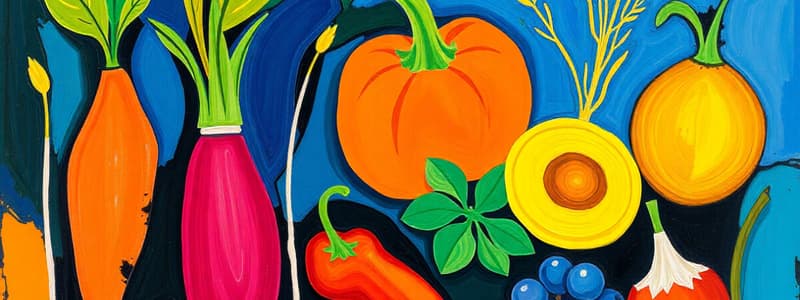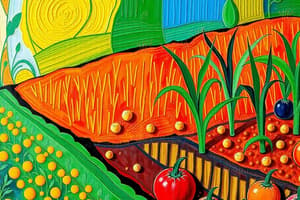Podcast
Questions and Answers
The main sources of food are ______, ______, ______.
The main sources of food are ______, ______, ______.
plants, animals, and other living organisms
The Indian population is less than one billion people.
The Indian population is less than one billion people.
False (B)
What are the main components of food that provide nutrients to living beings?
What are the main components of food that provide nutrients to living beings?
Carbohydrates, proteins, fats, vitamins, and minerals are the main components of food that provide nutrients to living beings.
Which of the following are examples of cereals?
Which of the following are examples of cereals?
What is the main purpose of 'Green Revolution'?
What is the main purpose of 'Green Revolution'?
What is the main purpose of 'White Revolution'?
What is the main purpose of 'White Revolution'?
What are the two main categories of crop seasons?
What are the two main categories of crop seasons?
Which of these is not an example of Kharif season crops?
Which of these is not an example of Kharif season crops?
What are the three main categories of activities involved in improving crop production?
What are the three main categories of activities involved in improving crop production?
Match the following nutrient types with their specific characteristics:
Match the following nutrient types with their specific characteristics:
What are the three main sources from where plants obtain nutrients?
What are the three main sources from where plants obtain nutrients?
Manure is an organic substance that provides essential nutrients to the soil.
Manure is an organic substance that provides essential nutrients to the soil.
Which of the following is a way to make compost?
Which of the following is a way to make compost?
Green manure is a type of fertilizer that is produced by chemical processes.
Green manure is a type of fertilizer that is produced by chemical processes.
What is the main purpose of crop rotation?
What is the main purpose of crop rotation?
Crop protection management aims to protect crops from pests and diseases.
Crop protection management aims to protect crops from pests and diseases.
What are the two main types of factors that can affect crop storage?
What are the two main types of factors that can affect crop storage?
Which of the following is not a benefit of organic farming?
Which of the following is not a benefit of organic farming?
Drying is a crucial step in ensuring the long-term storage of crops.
Drying is a crucial step in ensuring the long-term storage of crops.
What are some key precautions that need to be taken when storing crops?
What are some key precautions that need to be taken when storing crops?
Which of the following is not a main purpose of cattle farming?
Which of the following is not a main purpose of cattle farming?
Drought animals are cattle that are primarily raised for milk production.
Drought animals are cattle that are primarily raised for milk production.
What are the two main types of fish production?
What are the two main types of fish production?
What does 'Aqua culture' refer to?
What does 'Aqua culture' refer to?
Marine fishing focuses solely on catching fish in freshwater bodies.
Marine fishing focuses solely on catching fish in freshwater bodies.
What is the main purpose of composite fish culture?
What is the main purpose of composite fish culture?
What is the main goal of beekeeping?
What is the main goal of beekeeping?
Apiaries are facilities where bees are raised for their honey and beeswax.
Apiaries are facilities where bees are raised for their honey and beeswax.
What is the name of the European honey bee species?
What is the name of the European honey bee species?
Pasturage is the term used for areas where crops are sown for commercial purposes.
Pasturage is the term used for areas where crops are sown for commercial purposes.
The quality of honey is primarily influenced by the type of flowers that bees visit.
The quality of honey is primarily influenced by the type of flowers that bees visit.
Flashcards
Crop Improvement
Crop Improvement
Methods to enhance crop yield, quality, and resistance to diseases and environmental stresses.
Higher Yield
Higher Yield
Increasing the amount of crops produced per unit of land.
Improved Quality
Improved Quality
Enhancing the characteristics of crops like protein content and taste.
Biotic Resistance
Biotic Resistance
Signup and view all the flashcards
Abiotic Resistance
Abiotic Resistance
Signup and view all the flashcards
Nutrient Management
Nutrient Management
Signup and view all the flashcards
Macronutrients
Macronutrients
Signup and view all the flashcards
Micronutrients
Micronutrients
Signup and view all the flashcards
Manure
Manure
Signup and view all the flashcards
Fertilizer
Fertilizer
Signup and view all the flashcards
Mixed Cropping
Mixed Cropping
Signup and view all the flashcards
Intercropping
Intercropping
Signup and view all the flashcards
Crop Rotation
Crop Rotation
Signup and view all the flashcards
Organic Farming
Organic Farming
Signup and view all the flashcards
Study Notes
Food Sources
- Humans need food for growth and health
- Food provides nutrients like carbohydrates, proteins, fats, vitamins, and minerals
- Plants and animals are the main sources of food
Growing Food Supply
- India's population is large and growing rapidly
- Increasing food production is crucial for this growing population
- Agriculture needs improvement regarding crop varieties and management
- Crop protection management is crucial
- Expanding arable land is important
Crop Improvements
- Crop varieties need improvement
- Crop management practices need advancement
- Crop protection management is essential for higher yields
Types of Crops
- Cereals (wheat, rice, corn, millet) provide carbohydrates
- Seeds (apples, cherries, etc.) as well as those like grains, pulses, and peanuts provide fats
- Legumes and pulses (chickpeas, peas, lentils) provide proteins
- Vegetables, spices, and fruits provide vitamins and minerals
Crop Seasons
- Different crops have different growing needs (temperature, moisture, sunlight hours)
- Kharif crops are grown during the monsoon season (June-October)
- Rabi crops are grown in the winter season (November-April)
Crop Production Improvement
-
Crop variety improvement:
- Higher yields
- Improved quality
- Resistance to biotic (diseases, pests) and abiotic (drought, salinity) stresses
- Wide adaptability
- Desired agronomic traits (e.g., tall, dense branches for fodder crops)
-
Crop production management:
- Nutrient management
- Irrigation
- Cropping patterns
Nutrient Management
- Plants need nutrients (like nitrogen, phosphorous, potassium) from the air, water, and soil
- Macronutrients are needed in large quantities (nitrogen, phosphorus, potassium, calcium, magnesium, sulfur)
- Micronutrients are needed in small quantities (iron, manganese, boron, zinc, copper, molybdenum, chlorine)
- Manure is an organic source of nutrients for soil improvement
- Compost and vermicompost are types of manure
- Fertilizers are chemical sources of nutrients
Crop Protection Management
- Protecting crops from pests (insects, diseases, weeds) is essential
- Pest control methods can be used during crop growth and during storage
- Weeds are undesirable plants that grow along with crops.
- Insects damage plants in various ways.
- Plant pathogens are living organisms like bacteria, fungi, and viruses that cause diseases.
Crop Storage
- Proper storage of grains is necessary for year-round food availability
- Proper storage techniques need to be followed
Other Agricultural Practices
- Organic farming avoids chemical fertilizers and pesticides, offering environmentally friendly farming practices
- Animal husbandry methods involve proper care of domestic animals for milk, meat, and other purposes
- Aquaculture (fish farming) involves raising fish in controlled environments
Irrigation Methods
- Wells, tube wells, canals, and tanks are used for irrigation
- Rainwater harvesting is a water conservation technique
- Different methods of irrigation are used such as mixed cropping, intercropping, and crop rotation
Fish Farming
- Raising fish in water bodies is called fish farming
- In fish farming various methods are used like composite fish culture (raising five different species of fish)
- Marine fish farming is similar.
- Water bodies need to be maintained for sustainable fish farming
Beekeeping
- Beekeeping is the process of raising honeybees
Studying That Suits You
Use AI to generate personalized quizzes and flashcards to suit your learning preferences.




